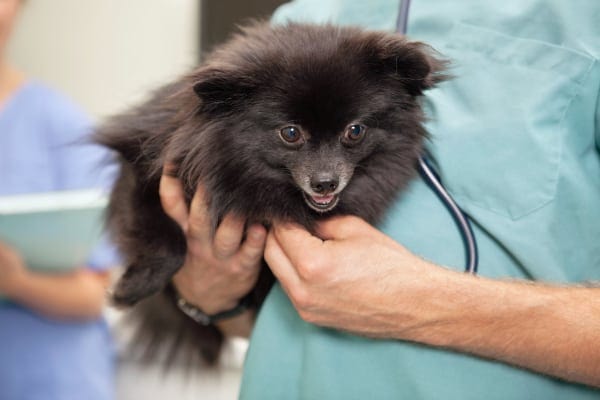Heart disease in dogs is an umbrella term used to describe many different canine heart conditions which can have a variety of causes. To help you navigate heart disease in dogs, integrative veterinarian Dr. Julie Buzby defines heart disease in dogs, explains how it relates to heart failure in dogs, uncovers what abnormalities of the heart can lead to signs of heart disease, and shares the three most common heart conditions in dogs.

Regardless of the exact type of heart disease your dog has, it is understandably a scary diagnosis to receive. After all, proper heart function is vital to your dog’s survival and wellbeing.
In order to best support and advocate for your dog with heart disease, it is important to have a general understanding of how the heart functions, why heart disease (and eventually heart failure) occurs, how to recognize the symptoms of heart disease, and what the treatment for heart disease entails. Plus, it is helpful to know the basics about the three most common heart diseases in dogs.
What is heart disease in dogs?
Heart disease in dogs is an all-encompassing term for many different conditions that alter heart anatomy and function. Sometimes the heart disease is congenital, meaning it has been present from birth. This is the most common type of heart disease in puppies. Alternatively, other dogs, particularly middle-aged and senior dogs, may have acquired heart disease. In this situation, the heart starts out normal but then becomes abnormal over time.
To better understand heart disease, it helps to think about what the heart has to do and how changes to the heart’s components can affect its function.
Heart anatomy
In short, the heart’s main job is to be the pump that sends blood all over the body. It is made up of four chambers—a left and right atrium and a left and right ventricle. Between each atrium and ventricle lies a valve that opens and closes at the appropriate times to ensure unidirectional blood flow through the heart. This valve is called the mitral valve on the left side of the heart and the tricuspid valve on the right side.
De-oxygenated blood is collected from the body and enters the right atrium via a large vessel called the vena cava. Then the tricuspid valve opens to allow blood to enter the right ventricle. The tricuspid valve tightly closes as the heart pushes blood forward into the pulmonary artery. This large vessel carries blood to the lungs where it exchanges the carbon dioxide it is carrying for oxygen.
The oxygenated blood returns to the left atrium via a large vessel known as the pulmonary vein. From the left atrium, the blood travels through the open mitral valve into the left ventricle. The mitral valve then closes tightly so that when the heart pumps, the oxygenated blood is pushed out to the body through another large vessel called the aorta.

Changes in heart components lead to heart disease
In order to work correctly and efficiently, the heart relies on the following components:
Heart muscle
The heart muscle must be strong enough to push blood out of the heart and through the vessels. If it becomes weak, such as in dilated cardiomyopathy, the heart is no longer an effective pump.
Heart chambers
It is important that the heart chambers be the right size so they hold the correct amount of blood. Sometimes if the chamber receives more blood than normal, it will get stretched out.
Heart valves
In order to maintain one-way blood flow through the heart and into the aorta and pulmonary artery, the heart has a series of valves that open then close tightly at the appropriate times. Leaky valves, such as occur in mitral valve disease, can cause blood to flow backward into the atrium. And narrowing of the valve or area just below the valve, such as occurs in pulmonic stenosis or subaortic stenosis, forces the heart to work harder to get the blood through the valve.
Electrical system
The heart’s electrical system coordinates the contraction and relaxation of the heart muscle cells, which is necessary to pump the blood. And it helps ensure the heart contracts enough times in a minute to supply sufficient amounts of blood to the body or lungs.
Dogs sometimes develop an arrythmia (i.e. abnormal heart rhythm) due to a stand-alone problem with the electrical system. But they can also have an abnormal heart rhythm as a consequence of changes to the heart from other heart conditions.
Heart walls
It is important that there are no abnormal holes in the walls that separate the heart into the four chambers. Otherwise, if there is a hole between the atria or ventricles (i.e. atrial or ventricular septal defect) the blood will leak from one chamber to another.
Healthy blood vessels
The vessels need to be free of debris and have normal walls to make it easy for the heart to send the blood through them. If, for example, heartworms have clogged and damaged the vessels in the lungs, the heart has to work harder to push blood through the vessels.
Normal blood vessel connections
In order for blood to go where it is supposed to, it is important that the blood vessels all attach to the heart in the right place and don’t have any abnormal connections to each other. For example, puppies may have a heart condition called a patent ductus arteriosus (PDA). This occurs when the vessel that allows the blood to bypass the lungs in fetal circulation doesn’t close at birth. Because of this abnormal connection between the aorta and pulmonary artery, oxygenated blood mixes with the deoxygenated blood.
When there is a problem with any one of those components of the heart, or a combination of those components, the diagnosis is heart disease in dogs. However, heart disease is not the same as heart failure. It is important to realize that in some cases, a dog may have heart disease for years before going into heart failure.
What is the difference between heart disease and heart failure in dogs?
Initially, the heart may be abnormal but still able to work appropriately. Since heart function is so important for survival, the body has lots of compensatory mechanisms to keep circulation as normal as possible. As long as the heart is functioning adequately, the dog just has heart disease, not heart failure.
However, eventually the heart disease takes such a toll on the heart that despite the compensatory mechanisms, it can no longer keep up with pumping blood through the body and lungs. Now the dog is in heart failure in addition to having heart disease.
When the heart fails, not enough blood is exiting the heart to supply oxygen to the tissues. Plus, the blood backs up in the vessels of the lungs or body as it waits to get through the heart. This blood “traffic jam” causes fluid to exit the vessels and enter the tissue.

The end result is pulmonary edema (i.e. fluid in the lung tissue), pleural effusion (i.e. fluid in the chest cavity), pericardial effusion (i.e. fluid in the sac around the heart), ascites (i.e. fluid in the abdomen), and/or subcutaneous edema (i.e. fluid under the skin). Where the fluid accumulates depends on if the left side of the heart, right side of the heart, or both sides of the heart are failing.
This state of fluid accumulation due to poor heart function is called congestive heart failure (CHF) in dogs.
What are the symptoms of heart disease in dogs?
Dogs who only have heart disease may or may not be showing any symptoms. Often, the vet finding a heart murmur on the physical exam is the only indication of heart disease. On the other hand, once a dog’s heart begins to fail, he or she usually exhibits more symptoms.
Early signs of heart disease
Early on in the disease, you may not see any symptoms. Or you might notice the following signs:
Lethargy or exercise intolerance
Your dog may be a lethargic dog and not want to go on walks or play like usual. Or he or she may quickly become tired and need to take a rest.
Coughing
You may notice your dog coughing and gagging, especially at night. Sometimes coughing is one of the signs of fluid in the lungs (i.e. pulmonary edema). Or in other cases, an enlarged left atrium may be pressing on the area of the trachea where it splits to go into the lungs. This can also trigger coughing.
Later signs of heart disease
As the heart disease progresses, your dog may show these additional signs:
Difficulty breathing
You may notice your dog breathing fast. Or he or she may be panting when it isn’t warm outside or taking abnormal-looking breaths. In severe cases, you may notice your dog standing with the neck outstretched and the elbows winged out from the body. This posture is called orthopnea and it signals severe respiratory distress.
Dark or bluish gums
Additionally, you may notice your dog’s gums turning a dark or bluish color. This is a sign that he or she isn’t getting enough oxygen.
Weight loss
Sometimes dogs with heart disease may lose weight, especially if the heart disease has been going on for awhile or is severe. Dogs who can’t breathe well are less likely to want to (or be able to) eat. This can contribute to weight loss.
Swelling of the abdomen
You may notice a pot-belled dog appearance due to fluid accumulating in the abdomen.
Collapse
If your dog has an arrythmia or the heart suddenly can’t keep up with the demands of the body, you might notice he or she faints or collapses.
Difficulty resting or sleeping
Since it can be harder for a dog with heart failure to breathe when lying down, you may notice your dog is restless or only sleeps for a few minutes before getting up again.

Make an appointment with your vet or an ER vet visit
If you see any of these signs, schedule an appointment with a vet promptly. You may be able to wait for an appointment with your regular vet if your dog’s signs are mild. But if your dog is in respiratory distress, has collapsed, or is showing other severe symptoms, it is best to make an emergency vet visit.
How is heart disease diagnosed?
If your dog is in respiratory distress when you arrive for the appointment, the first thing the vet will do is stabilize your dog with oxygen and potentially medications. Then once your dog is breathing better, he or she can safely perform more diagnostic testing.
As part of the diagnostic process, the vet will perform a physical exam. He or she will listen for a heart murmur in dogs, which may indicate an abnormality with the heart valves. And the vet will also measure your dog’s heart rate and listen for abnormal rhythms. When assessing the lungs, the vet will listen for crackles or changes in the lung sounds. And he or she will count your dog’s respiratory rate.
Additional diagnostics
From there, the vet may recommend additional tests to diagnose heart disease such as:
- Chest X-ray—A chest X-ray allows the vet to evaluate the size and shape of the heart. Plus, he or she can look for signs of fluid in the chest and assess the vessels in the lungs.
- EKG—An electrocardiogram (EKG) shows the electrical activity of the heart. This information can help your vet detect and identify abnormal heart rhythms. Occasionally, the vet may have your dog wear a Holter monitor. This tool records an EKG over a longer period of time (a day or more) to quantify arrythmias or catch intermittent arrythmias.
- Echocardiogram—An ultrasound of the heart (i.e. echocardiogram) allows the vet to evaluate the heart wall thickness and chamber size. Plus, he or she can look at the valves and watch the heart contract. An echo is a great way to definitively diagnose the cause of the heart disease and evaluate the heart. However, most general practice vets don’t perform echocardiograms. So your vet may refer your dog to a veterinary specialist near you, namely a cardiologist, for this test.
These tests give information that helps your vet figure out what type of heart condition your dog may be facing. And they also help him or her determine which stage of heart disease your dog is in.
What are the stages of heart disease in dogs?
Different heart conditions may have slightly different stages. But in general, a dog with heart disease will fall into one of the following four categories:
Stage A (at-risk)
The dog is at risk for heart disease due to his or her age or breed but does not currently have heart disease.
Stage B (changes to the heart but no symptoms)
While still asymptomatic, the vet can now detect changes to the structure or function of the heart on X-ray or echocardiogram.
Stage C (symptomatic)
The heart disease has progressed to the point that the dog is showing symptoms of heart disease or heart failure.
Stage D (end-stage heart disease in dogs)
In stage D, the dog has congestive heart failure that is no longer responsive to standard treatments. At this point, if not before, the family may need to make a decision about when to euthanize their dog with heart failure.
What is the treatment for heart disease in dogs?
Once the vet knows the type and stage of heart disease your dog is in, he or she will create a treatment plan. Some potential treatments for heart disease include:
- Oxygen therapy—A dog in respiratory distress may need supplemental oxygen.
- Diuretics—The vet may use diuretics like furosemide to help remove fluid from the lungs or other parts of the body.
- Positive inotropes—Medications such as pimobendan (Vetmedin®) that help the heart contract more strongly can be beneficial in some heart conditions.
- Anti-arrhythmics—Since arrythmias can be fatal, the vet may recommend anti-arrhythmic medications.
- ACE-inhibitors—Medications like enalapril for dogs can help counteract some of the negative effects of the body’s compensatory mechanisms. And they make it easier for the heart to pump blood into the vessels.
- Abdominocentesis or thoracocentesis—The vet may use a needle to drain fluid from the abdomen (i.e. abdominocentesis) or the space around the lungs (i.e. thoracocentesis).
- Surgery—Some congenital heart defects, such as a PDA, can be corrected surgically.
- Low-sodium diet—A low-sodium veterinary prescription diet or low-sodium homemade diet formulated by a veterinary nutritionist can be helpful for dogs with heart failure.
What types of heart disease affect middle-aged and senior dogs?
Now that you have a better understanding of heart disease in general, let’s take a look at three common heart conditions in middle-aged or senior dogs.
1. Mitral valve disease in dogs
Mitral valve disease in dogs is the most common form of heart disease in dogs. As many as 10% of dogs over 10 years old have mitral valve disease. This is a condition we most frequently see in smaller/toy breeds.

In dogs with mitral valve disease, the flaps of the mitral valve begin to degenerate. Since they are now wrinkled and lumpy instead of flat and smooth, they don’t form a complete seal anymore as the heart pumps.
This allows blood to flow backward from the ventricle back into the atrium. This turbulent blood flow causes an audible murmur. Because the mitral valve separates the left atrium from the left ventricle, the vet will typically hear the murmur on the left side of the chest.
Since not all of the blood goes from the left ventricle into the aorta, the heart now has to work harder to get oxygenated blood to the rest of the body. The extra blood in the atrium also stretches out the walls of the atrium. These changes in the size and function of the heart can cause symptoms of heart disease or heart failure.
Unfortunately, the valves can never go back to normal. But medications can help manage and slow the progression of mitral valve disease and congestive heart failure (CHF).
2. Dilated cardiomyopathy (DCM) in dogs
Dilated cardiomyopathy (DCM) in dogs is another type of canine heart disease, but this one occurs more commonly in larger dogs.
Dogs with DCM have a weakening of the heart muscle, specifically in the ventricles. This makes the heart less effective at pumping blood to the body. And the ventricles become dilated (hence the name of the disease) and thin-walled. As the heart’s pumping ability continues to decline, blood volume backs up. This leads to congestive heart failure and fluid accumulation in the lungs.

In most cases, dilated cardiomyopathy is caused by a dog’s genetics, which is why we see it more often in certain breeds like Dobermans Pinchers, Boxers, and Great Danes. Even though it is inherited, it takes time to progress to the point where the dog starts showing clinical signs. So DCM is more common in middle-aged to older dogs.
However, DCM can also be nutritional.
Can feeding my dog a grain-free diet cause dilated cardiomyopathy?
The FDA reported a possible link between certain diets and canine dilated cardiomyopathy in 2018 and the investigation is ongoing. Vets noticed increasing numbers of dogs who were developing dilated cardiomyopathy but were not one of the genetically predisposed breeds. And many, but not all of the dogs who developed DCM were eating a grain-free or legume-rich diet.
At this point, the FDA has concluded that non-hereditary dilated cardiomyopathy is complex and multi-factorial. And they recommend you talk to your veterinarian for specific dietary recommendations.
Just like with mitral valve disease, veterinarians can prescribe medications to help manage dilated cardiomyopathy and associated congestive heart failure.

3. Heartworm disease in dogs
Who doesn’t hate mosquitos? Not only because they bite us, but also because they are the vector that transmits heartworm disease in dogs. Mosquitos pick up larval heartworms in blood meals from infected dogs, then spread them to other dogs through biting.
Adult heartworms live in the right side of the heart and pulmonary arteries. The worms can be very large, up to 14 inches long, so they take up space and make it hard to get blood past them. They also cause inflammation by irritating the heart and vessels.
All of this leads to turbulent blood flow. And the heart has to work extra hard to get blood through the lungs. While dogs with heartworm disease may start out asymptomatic, the changes to the heart and vessels can lead to congestive heart failure. This form of CHF may be accompanied by fluid accumulation in the abdomen and other heart disease signs. And severe heartworm infections can even cause sudden death.
Although heartworms can and do infect younger dogs, the clinical signs take some time to develop. So heartworm disease is more common in middle-aged or senior dogs.
Heartworm disease testing and prevention
All dogs living in places where heartworm disease is common should have a yearly heartworm test. This blood test for dogs is a great way to detect heartworm disease before a dog becomes symptomatic. That way the vet can start treatment before the worms lead to permanent heart and lung damage.
However, even more ideal than detecting it early is preventing heartworm disease entirely. There are many options available for heartworm prevention that you can discuss with your veterinarian. Keeping your dog on year-round heartworm prevention is one of the most important things you can do.

A hearty conclusion
When it comes to canine heart disease, early diagnosis is essential. Because clinical signs often only develop as the condition becomes more severe, even the most astute pet parent may not realize their dog is affected at first.
This is one of the many reasons it is important to bring senior dogs in for more frequent veterinary examinations as they get older. If your dog is diagnosed with heart disease, work closely with your veterinarian to develop a management plan. Then, diligently report any changes in your dog’s condition to your vet.
Has your dog been diagnosed with heart disease?
Please comment below. We can all support and encourage each other.


Hello,
I am writing to you about my sweet Bailey chihuahua 13 years and 9 months old.
Bailey was still fit and playful
. Sometimes he coughed in the morning when he woke up but never the rest of the day.
Bailey took Vetmedin 2 x a day for the past 3 years. One evening at 00.00 Bailey suddenly had a swollen face/muzzle/eyes and became restless, started digging and became short of breath, we immediately went to the vet with him. The vet thought it was an allergic reaction and gave him an injection with Dexthametason.
He gave Prednicortone to take home.
4.5 hours later nothing had changed in the situation and Bailey was given Prednicortone 3.75 MG from then on it only went downhill with him, he got air hunger, breathed very quickly and had a heart attack 4.5 hours later in my arms in front of the vet door. I feel so incredibly guilty!! life has been hell since then.
i have a feeling i killed him with the prednicortone. could the prednicortone have caused this heart attack? is a swollen face a symptom of CHF? does prednicortone work on the heart? i look forward to hearing from you. thank you!
kind regards, Cindy.
Dear Cindy,
I am so sorry for the tragic loss of your beloved Bailey. I have never heard of CHF causing a swollen face, but I can’t say it isn’t a possibility. I absolutely would have done the same thing as your vet as this sounds like a life-threatening allergic reaction/anaphylaxis. While I can’t make specific conclusions, I would assume your boy probably passed away from continued effects of the allergic reaction and not necessarily from how the steroids affected his heart condition. Please don’t continue to carry around guilt over how things progressed. You didn’t do anything wrong and there was likely no way to change the outcome for your sweet boy. I hope with time your heart can begin to heal, and you can find peace. May Bailey’s memory stay with you always. ♥
We sadly just lost our 10 year old mini Goldendoodle to CHF. The signs were so subtle and came on so quickly I just thought he was slowing down because of age. No abnormal health visits, regular yearly vet visits and teeth cleanings. Very active and healthy appearance. About 2 weeks before I did see some signs of exercise intolerance and nighttime panting. A few days before he went into CHF, we went for our normal walk and he came home and vomited. He perked right back up to normal when we went out of town to a family reunion, he came with because everyone loves him. He played pretty hard his last good day with the kids with his frisbee ring and squeaky ball, where I did begin to get concerned because he was struggling to catch his breath like normal after playing. Slept like normal that night, and woke up fine the next morning, but mid morning I think he might have passed out because he fell off the bed and had a scared look in his eyes. I babied him and tried to get into see a local vet since we were still out of town, but they refused to see him. By evening he was very lethargic and started vomiting quite a lot. We made the decision to drive 1 1/2 hours to the closest emergency vet that would see us. He was so cold and barely moving, it was so scary. The prognosis was not good with kidney failure setting in, along with a pericardial effusion and pancreatitis as well as elevated WBC count. It was the hardest and worst decision I’ve ever had to make to let him go. I wish every day that I would’ve taken those slight signs more seriously and taken him into the vet sooner. Love you dogs and treat them well while you have them please! They leave us too soon!
Dear Kimberlee,
My heart aches for you with the recent loss of your senior boy. It is easy to feel guilty as your brain ponders all the “what ifs” but please don’t blame yourself for how things progressed. You gave your pup nothing but love and I am certain he knew how much he meant to everyone. I am glad you were able to offer him a peaceful passing and free him from unnecessary suffering. As time passes, I pray your heart will begin to heal and you can find comfort. May his memory stay with you always and continue to be a blessing in your life.
My 9 yr old Pomeranian/maltese mix has been diagnosed with mitral valve disease. Had an x-ray and echocardiogram and is on medication. She has had 2 horrid fainting incidents, in the last week started with screaming, thrashing around, followed by unconsciousness., lasting for a couple of minutes, she urinates while it occurs. I cuddle her even though she is unaware. These incidents are started by her running around and barking. I have blocked off my yard so she can’t run, but it still happened. She has no cough, but does pant a lot. I am giving her CBD gummies to calm her down. She spend 1st part of her life in a crate, a breeder dog and was dumped. I have had her for a year.
Dear Deanna,
I am so sorry your senior girl is struggling with heart disease. It sounds like she is experiencing syncope and I agree this is cause for concern. Please make sure your vet is aware of these recent episodes. They may need to adjust her medications or add in something to help keep her calm. You can always ask for a consultation with a veterinary cardiologist if needed. Hoping you can find a way to maintain her quality of life for as long as possible. Wishing you both the best of luck. Bless you and your sweet girl.
Our 14 year old, 10 pound yorkiepoo has had a heart murmur for a few years and recently has started coughing once or twice a day. He also is suspected of having Inflammatory Bowel Disease and has flare-ups on occasion especially if he happens to eat beef. Otherwise, he’s very active, happy and quite a character.
We recently moved and our new vet started him on vetmedin (2.5mg in the morning and another 2.5mg in the evening) as well as furosemide daily. Within 12 hours of starting them, he quit eating and started vomitting and having diarrhea. We stopped after three doses and his appetite came back and vomitting stopped. We decided to reduce the dosage and after two half pills, the vomitting and diarrhea came back with a vengeance, including vomitting blood and passing blood. Needless to say, we immediately stopped the medicine and went back to the vet.
He was adamant that it wasn’t the medication since he’d never heard of that type of reaction to it, however, two days after stopping it, he was back to normal and eating like a champ. He suggested it might have been a reaction to the flavoring in the vetmedin but the beef flavoring is artificial so that doesn’t seem right.
Since this is a new vet, we’re not sure exactly how we’re going to proceed but for sure, we will not be repeating giving him the Vetmedin.
Dear Becky,
I am so sorry you are dealing with this worrisome situation with your senior pup. I understand your concern and can see why you are conflicted on how to proceed. Without being personally involved in your dog’s medical care it is hard to make specific conclusions about why certain decisions have been made. If you are uncomfortable with the care your boy is receiving it is ok to get a second opinion. Not every clinic is the best fit for each patient. Thats why it is good there are so many options! You deserve to feel confident in the care you are receiving and need to find a vet with whom you can partner to give your sweet boy the attention he needs. You can also ask for a consultation with a veterinary cardiologist if you would be interested in an expert opinion. Hoping you can find the answers you need to navigate this difficult path. Wishing you all the best and praying for a positive outcome.
Hi there. I have a 13 year old Pomeranian and has similar problems to yours. He is on Vetmedin for his heart. We found a Holistic Vet that prescribed CBD. The CBD works very well. A lot of his symptoms like the panting, shaking, restlessness and trouble sleeping, anxiety have calmed down. He is like a young pup again. More confident and secure. I find taking him to Chiropractor also helps his nervous system and helps the coughing as well because his neck becomes subluxated from coughing so much. Hope this helps. :))
Hi Pam,
Thank you for sharing your experience and knowledge with our readers. I am so glad your senior boy is doing better since starting these integrative therapies. Wishing you continued success and bless you both!
15 yr old Maltese with diagnosed heart mumer and is struggling with a constant rasping cough. . how to keep her comfortable. possibly low dose anxiety medicine
Hi Laurie,
I am sorry your senior girl is having difficulty breathing. Is your vet aware of the rasping cough? These could be signs of a worsening heart condition (congestive heart failure). Before trying anti-anxiety drugs, it could be more beneficial to get her started on some heart medications. I strongly recommend you discuss this with your vet and see what they think is best. Hoping you can find a way to ensure your sweet girl is happy and comfortable. Wishing you all the best.
I have a Cavachon King Charles and she started out with a cough that eventually got worse that sounded like a duck. We found out after it was heart disease and have had her on meds since. Now, her cough is SO bad, nonstop panting, eyes bulging, shaking uncontrollably, whimpering, non sleeping/resting, and has a nervous breakdown if one of tries to step out. The vet say to bring her in but I personally feel there just going to run loads of more tests just too tell me we’re losing her and now we’re stuck with a 5k+ bill. We’re devastated and don’t know what to do but keep her comfortable at home. This so heartbreaking too watch my dog-child suffer. My heart goes out too all the pet owners loving on their pets watching them struggle.💔
Hi Jessica,
My heart goes out to you as you face this difficult situation with your senior girl. From what you describe, it sounds like she is really struggling and may be suffering as well. I think it would be best to take her to your vet and have them do a quality-of-life assessment. I know you don’t want to spend tons of money on testing and that is ok. You get to call the shots at the vet office and if all you want is an exam then let them know that upfront. Even if you choose not to pursue testing or treatment, something is needed to help offer your girl comfort and relief. Palliative care is always a great option. And it may be that your pup is past the point of palliative care and saying goodbye might be the most loving choice and only way to prevent unnecessary suffering. Ultimately, the first step is getting your girl evaluated and then you will know what decisions you need to make. Wishing you clarity and peace as you navigate this tough road ahead. Bless you and your sweet girl.
My 13 yr old Pomeranian was diagnosed with CHG. She’s now coughing most times. She does have periods of rest, However, the majority of the time she is breathing heavy whether resting or awake, Her eyes are starting to bulge out due to overworking to get oxygen. She is becoming restless, and had a seizure yesterday-where she lost control over her legs and her whole body and shivered for a few minutes. I picked her up, cuddled, petted her calmly, all the while whispering in her hear to just relax and breathe, .Is she roughly in Stage 3 or 4?
Dear Lori,
What you describe has me very concerned for your pup’s well-being. I am not sure what stage to categorize this under but feel like it would be best to contact your vet right away. Your girl may be suffering and nearing her final days. I am afraid you may be facing some hard decisions about her quality of life. Praying you can get the answers you need to make the best choice for everyone involved. Bless you and your senior girl.